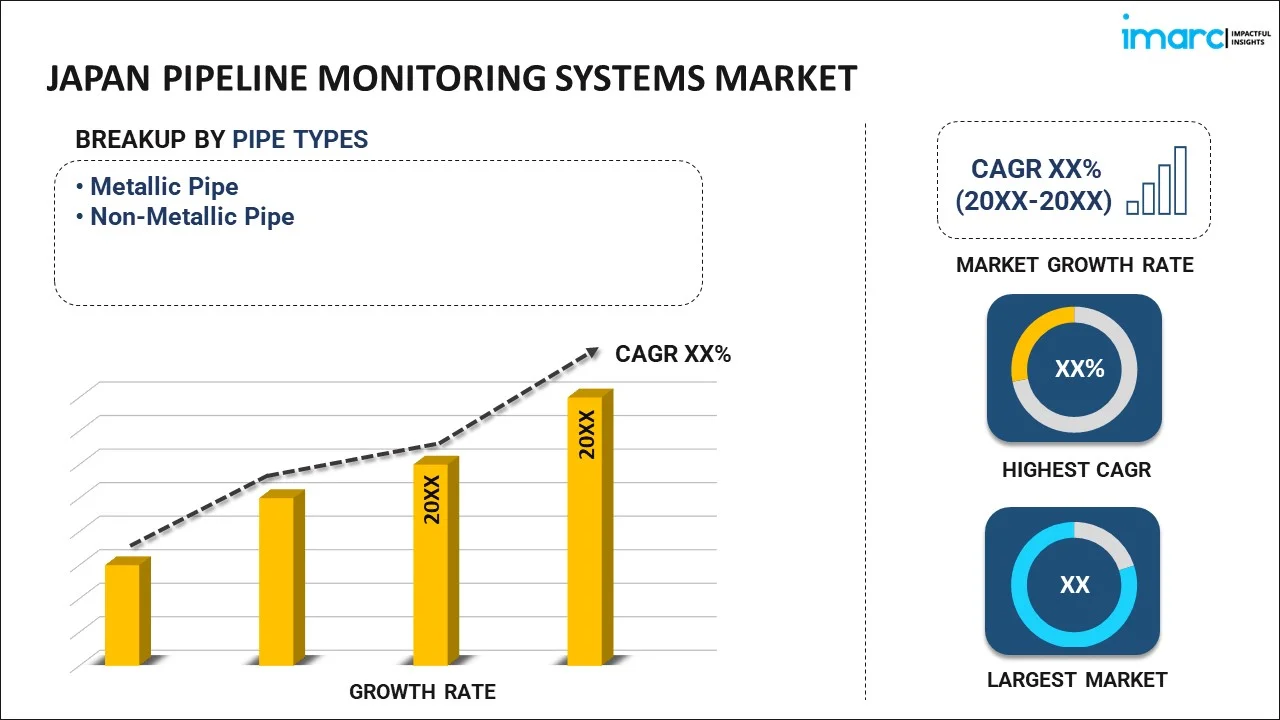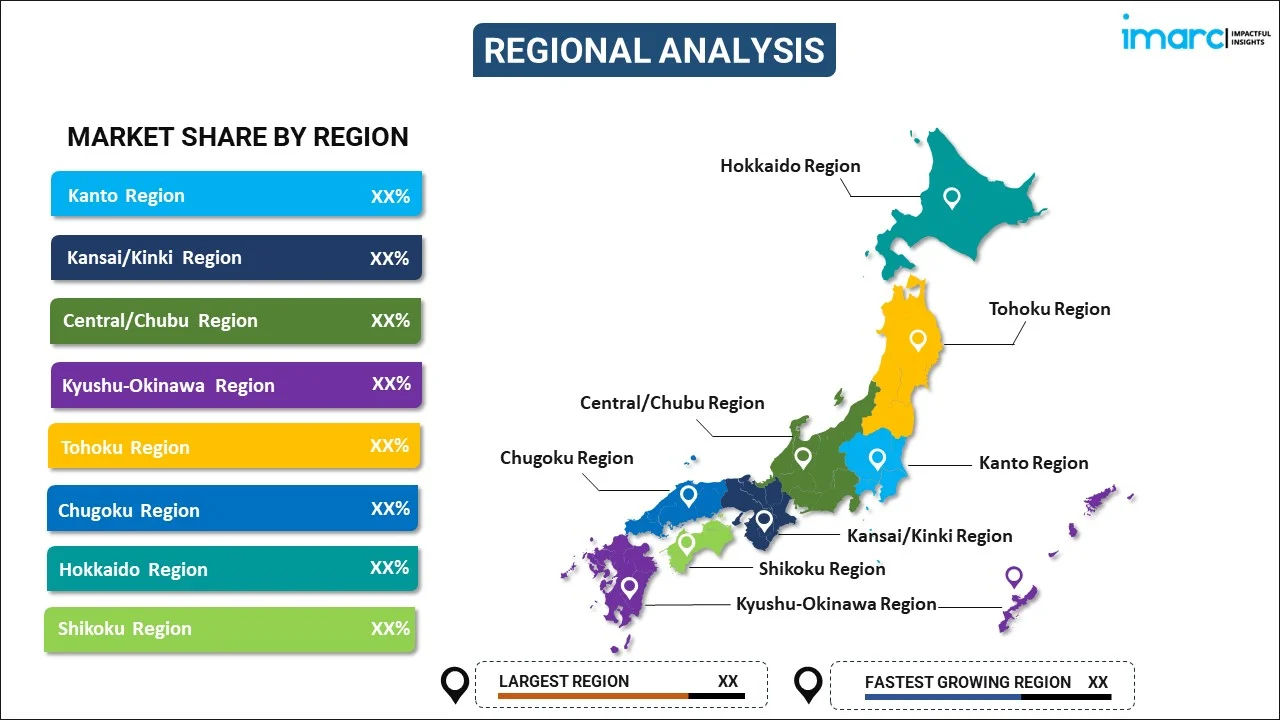
Japan Pipeline Monitoring Systems Market Report by Pipe Type (Metallic Pipe, Non-Metallic Pipe), Technology (Ultrasonic Testing, Smart Ball, Magnetic Flux Leakage Technology, Pipeline Inspection Gauges (PIGs), and Others), Application (Leak Detection, Pipeline Break Detection, Operating Condition, and Others), End Use Industry (Oil and Gas, Water and Wastewater, and Others), and Region 2025-2033
Market Overview:
Japan pipeline monitoring systems market size reached USD 778.5 Million in 2024. Looking forward, IMARC Group expects the market to reach USD 1,457.4 Million by 2033, exhibiting a growth rate (CAGR) of 6.67% during 2025-2033. The market is driven by government initiatives, advanced technologies, and increased use of metallic pipelines, along with investments in R&D and enhanced operations.
|
Report Attribute
|
Key Statistics
|
|---|---|
|
Base Year
|
2024 |
|
Forecast Years
|
2025-2033
|
|
Historical Years
|
2019-2024
|
| Market Size in 2024 | USD 778.5 Million |
| Market Forecast in 2033 | USD 1,457.4 Million |
| Market Growth Rate (2025-2033) | 6.67% |
Pipeline monitoring systems are widely used to assess bacteriological control programs and identify corrosion issues within pipelines. These systems typically gather data or samples without producing any harmful waste, ensuring compliance with regulatory monitoring mandates. They play a crucial role in detecting leaks, assessing operational conditions, overseeing pipeline networks, and identifying potential breaches, thus mitigating the possibility of catastrophic events like explosions or fires. As a result, they contribute to the optimization of productivity, enhancement of the production process, extension of asset longevity, and the improvement of safety and adherence to regulations. Currently, these pipeline monitoring systems are available in various types, including metallic and non-metallic variants.
Japan Pipeline Monitoring Systems Market Trends:
The pipeline monitoring systems market in Japan is experiencing robust growth, primarily driven by the increasing incidents of pipe leaks, fractures, corrosion, and damage in sectors like oil, wastewater, and refined petroleum. This growth is further bolstered by government initiatives aimed at promoting disaster management, workplace safety, and compliance with industry standards. Consequently, there is a growing adoption of pipeline monitoring systems in the crude and refined petroleum industries within Japan. The extensive integration of these systems with pipeline inspection gauges (PIGs), magnetic flux leakage technology, smart ball solutions, and various communication tools such as human-machine interfaces (HMI) and supervisory control and data acquisition (SCADA) for remote management and efficient operations is another key factor contributing to market growth. Furthermore, the widespread use of metallic pipelines in the oil and gas sector, known for their strength, flexibility, corrosion resistance, long-term sustainability, and ability to withstand high pressures, is driving market expansion in Japan. Additional factors such as substantial investments in research and development (R&D) to enhance production technology and reduce operating costs, coupled with increased oil and gas exploration activities, are expected to create a favorable environment for the pipeline monitoring systems market in Japan over the forecasted period.
Japan Pipeline Monitoring Systems Market Segmentation:
IMARC Group provides an analysis of the key trends in each segment of the market, along with forecasts at the country level for 2025-2033. Our report has categorized the market based on pipe type, technology, application, and end use industry.
Pipe Type Insights:

- Metallic Pipe
- Non-Metallic Pipe
The report has provided a detailed breakup and analysis of the market based on the pipe type. This includes metallic pipe and non-metallic pipe.
Technology Insights:
- Ultrasonic Testing
- Smart Ball
- Magnetic Flux Leakage Technology
- Pipeline Inspection Gauges (PIGs)
- Others
A detailed breakup and analysis of the market based on the technology have also been provided in the report. This includes ultrasonic testing, smart ball, magnetic flux leakage technology, pipeline inspection gauges (PIGs), and others.
Application Insights:
- Leak Detection
- Pipeline Break Detection
- Operating Condition
- Others
The report has provided a detailed breakup and analysis of the market based on the application. This includes leak detection, pipeline break detection, operating condition, and others.
End Use Industry Insights:
- Oil and Gas
- Water and Wastewater
- Others
A detailed breakup and analysis of the market based on the end use industry have also been provided in the report. This includes oil and gas, water and wastewater, and others.
Regional Insights:

- Kanto Region
- Kansai/Kinki Region
- Central/ Chubu Region
- Kyushu-Okinawa Region
- Tohoku Region
- Chugoku Region
- Hokkaido Region
- Shikoku Region
The report has also provided a comprehensive analysis of all the major regional markets, which include Kanto Region, Kansai/Kinki Region, Central/ Chubu Region, Kyushu-Okinawa Region, Tohoku Region, Chugoku Region, Hokkaido Region, and Shikoku Region.
Competitive Landscape:
The market research report has also provided a comprehensive analysis of the competitive landscape. Competitive analysis such as market structure, key player positioning, top winning strategies, competitive dashboard, and company evaluation quadrant has been covered in the report. Also, detailed profiles of all major companies have been provided.
Japan Pipeline Monitoring Systems Market Report Coverage:
| Report Features | Details |
|---|---|
| Base Year of the Analysis | 2024 |
| Historical Period | 2019-2024 |
| Forecast Period | 2025-2033 |
| Units | Million USD |
| Scope of the Report | Exploration of Historical and Forecast Trends, Industry Catalysts and Challenges, Segment-Wise Historical and Predictive Market Assessment:
|
| Pipe Types Covered | Metallic Pipe, Non-Metallic Pipe |
| Technologies Covered | Ultrasonic Testing, Smart Ball, Magnetic Flux Leakage Technology, Pipeline Inspection Gauges (PIGs), Others |
| Applications Covered | Leak Detection, Pipeline Break Detection, Operating Condition, Others |
| End Use Industries Covered | Oil and Gas, Water and Wastewater, Others |
| Regions Covered | Kanto Region, Kansai/Kinki Region, Central/ Chubu Region, Kyushu-Okinawa Region, Tohoku Region, Chugoku Region, Hokkaido Region, Shikoku Region |
| Customization Scope | 10% Free Customization |
| Post-Sale Analyst Support | 10-12 Weeks |
| Delivery Format | PDF and Excel through Email (We can also provide the editable version of the report in PPT/Word format on special request) |
Key Questions Answered in This Report:
- How has the Japan pipeline monitoring systems market performed so far and how will it perform in the coming years?
- What has been the impact of COVID-19 on the Japan pipeline monitoring systems market?
- What is the breakup of the Japan pipeline monitoring systems market on the basis of pipe type?
- What is the breakup of the Japan pipeline monitoring systems market on the basis of technology?
- What is the breakup of the Japan pipeline monitoring systems market on the basis of application?
- What is the breakup of the Japan pipeline monitoring systems market on the basis of end use industry?
- What are the various stages in the value chain of the Japan pipeline monitoring systems market?
- What are the key driving factors and challenges in the Japan pipeline monitoring systems?
- What is the structure of the Japan pipeline monitoring systems market and who are the key players?
- What is the degree of competition in the Japan pipeline monitoring systems market?
Key Benefits for Stakeholders:
- IMARC’s industry report offers a comprehensive quantitative analysis of various market segments, historical and current market trends, market forecasts, and dynamics of the Japan pipeline monitoring systems market from 2019-2033.
- The research report provides the latest information on the market drivers, challenges, and opportunities in the Japan pipeline monitoring systems market.
- Porter's five forces analysis assist stakeholders in assessing the impact of new entrants, competitive rivalry, supplier power, buyer power, and the threat of substitution. It helps stakeholders to analyze the level of competition within the Japan pipeline monitoring systems industry and its attractiveness.
- Competitive landscape allows stakeholders to understand their competitive environment and provides an insight into the current positions of key players in the market.
Need more help?
- Speak to our experienced analysts for insights on the current market scenarios.
- Include additional segments and countries to customize the report as per your requirement.
- Gain an unparalleled competitive advantage in your domain by understanding how to utilize the report and positively impacting your operations and revenue.
- For further assistance, please connect with our analysts.
 Inquire Before Buying
Inquire Before Buying
 Speak to an Analyst
Speak to an Analyst
 Request Brochure
Request Brochure
 Request Customization
Request Customization




.webp)




.webp)












